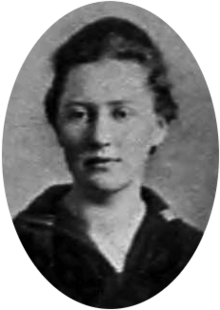
Back ثيودورا كروبر Arabic ثيودورا كروبر ARZ Тэадора Кробер Byelorussian Theodora Kroeber Catalan Theodora Kroeber German Theodora Kroeber Spanish تئودورا کروبر Persian Theodora Kroeber French Theodora Kracaw Kroeber Frisian Theodora Kroeber Galician
Theodora Kroeber | |
|---|---|
 Kroeber in 1919 | |
| Born | Theodora Covel Kracaw March 24, 1897 Denver, Colorado, U.S. |
| Died | July 4, 1979 (aged 82) Berkeley, California, U.S. |
| Alma mater | University of California, Berkeley |
| Occupations |
|
| Spouses | Clifton Brown
(m. 1920; died 1923)John Quinn (m. 1969) |
| Children | 4, including Karl and Ursula |
Theodora Kroeber (/ˈkroʊbər/ KROH-bər; née Theodora Covel Kracaw;[a] March 24, 1897 – July 4, 1979) was an American writer and anthropologist, best known for her accounts of several Native Californian cultures.[5] Born in Denver, Colorado, Kroeber grew up in the mining town of Telluride, and worked briefly as a nurse. She attended the University of California, Berkeley (UC Berkeley), for her undergraduate studies, graduating with a major in psychology in 1919, and received a master's degree from the same institution in 1920.
Married in 1920 and widowed in 1923, she began doctoral studies in anthropology at UC Berkeley. She met anthropologist Alfred Louis Kroeber during her studies, and married him in 1926. One of her two children with Kroeber was the writer Ursula K. Le Guin. The Kroebers traveled together to many of Alfred's field sites, including an archaeological dig in Peru, where Theodora worked cataloging specimens. On their return, Alfred encouraged Theodora to continue her graduate work, but she declined, feeling she had too many responsibilities.
Kroeber began writing professionally late in her life, after her children had grown up. She published The Inland Whale, a collection of translated Native Californian narratives in 1959. Two years later she published Ishi in Two Worlds, an account of Ishi, the last member of the Yahi people of Northern California, whom Alfred Kroeber had befriended and studied between 1911 and 1916. This volume sold widely and received high praise from contemporary reviewers. Retrospective reviews were more mixed, noting Kroeber's unflinching portrayal of Californian colonization but criticizing her perspective on Ishi's treatment.
Nine years after Alfred's death in 1960, Theodora Kroeber married artist John Quinn. Kroeber published several other works in her later years, including a collaboration with her daughter Ursula and a biography of Alfred Kroeber. She served as a regent of the University of California for a year before her death in 1979. She has been described as having influenced her husband's anthropological work, and as having inspired interest in indigenous culture through Ishi in Two Worlds. A 1989 biography stated that her "great strength was as an interpreter of one culture to another".[6]
- ^ Hines, Lori. "Finding Aid to the Theodora Kroeber Papers, 1881–1983 (bulk 1960–1979)". Online Archive of California. University of California, Berkeley. Archived from the original on April 22, 2019. Retrieved January 30, 2019.
- ^ Clements, Forrest E.; Schenck, Sara M.; Brown, Theodora K. (October 1926). "A New Objective Method for Showing Special Relationships". American Anthropologist. 28 (4): 585–604. doi:10.1525/aa.1926.28.4.02a00010. JSTOR 661296.
- ^ Clifford 2013, pp. 4–6.
- ^ Cite error: The named reference
Elsasserwas invoked but never defined (see the help page). - ^ Buzaljko 1989, p. 187.
- ^ Buzaljko 1989, pp. 190–191.
Cite error: There are <ref group=lower-alpha> tags or {{efn}} templates on this page, but the references will not show without a {{reflist|group=lower-alpha}} template or {{notelist}} template (see the help page).
© MMXXIII Rich X Search. We shall prevail. All rights reserved. Rich X Search